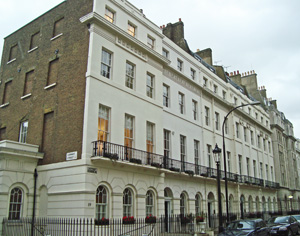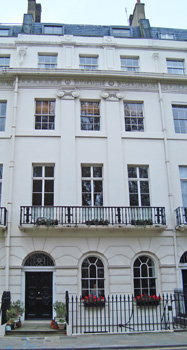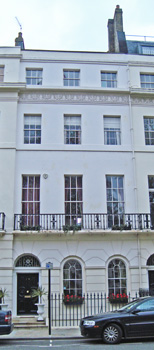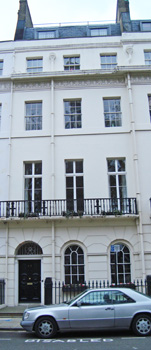Fitzroy House
16-17 Fitzroy Square, W1T 6EQ
Medical
dates:
Medical
character:
Nursing Home
Fitzroy House opened on 1st July
1880 at No. 16 Fitzroy Square. Established by the Home Hospitals
Association (for Paying Patients) at a cost of £10,523, it
was the first of the Association's 'home hospitals' and the first
paying hospital in the country.
Unlike other hospitals, the Home Hospital employed no medical staff. Patients were admitted under the independent care of their own family practitioners or consultant physicians. The institution was more like a medical boarding-house than a hospital. It provided skilled nursing care, rest and a regulated diet, with the comforts of home, for all classes who were prepared to pay a weekly charge of from 3 to 6 guineas (£3.15-£6.30).
The Home was furnished and decorated in good taste, with a feeling for comfort and cheerfulness. Its sanitary provisions were ideal.
There was no Out-Patients Department.
As with the voluntary hospitals, patients suffering from epilepsy, mental illness, infectious or contagious diseases were not eligible for admission, nor were incurable cases.
Those admitted with acute disease were expected to pay the cost of 14 days maintenance (if the patient stayed a lesser time, the money would be refunded. However, each had to pay for a week's residence). Before admission, patients or their friends were required to fill in a form of application. All expenses of bringing or removing the patient from the premises became the responsibility of the friends.
The Home proved a marked success. During its first year of operation, of the 446 patients who applied for admission, only 114 were received.
In 1881 the Management Committee decided to give up the 4-bedded ward due to the lack of privacy for patients and their visitors.
In 1890 as many as 92 medical practitioners attended patients in the Home (the average number over the previous ten years was 72).
By the late 1890s the Committee had been able to purchase No. 17 by mortgage and also No. 18, which was acquired for use as a Nurses' Home. The Home then had 40 rooms. The money for the extension had been raised by grants from City Companies; the Goldsmiths' Company gave £100, while the Clothworkers', Fishmongers', Grocers' and Mercers' Companies each gave 100 guineas (£105). The Merchant Taylors', Skinners', Salters', Leathersellers' and Vintners' Companies also contributed.
In 1898 electric light was installed, the first private hospital in which this had happened. The average number of patients for the year had increased from 251 (ten years ago) to 291. It was hoped to keep at least three-quarters of the available accommodation always occupied.
During 1903 some 415 patients were admitted, with an average stay of between 21 to 84 days. The weekly charge for an in-patient was from 4 to 10 guineas (£4.20 to £10.50). If a special nurse was needed, there was an extra charge of 3 gns (£3.15). The medical work was mainly confined to surgery, although the Home lacked laboratory and other hospital facilities.
In 1904 the Home was rebuilt at a cost of some £12,000. It then had 30 beds. An Appeal had been launched amongst those who had benefitted from treatment there, or who might benefit, but it proved unsatisfactory, as it implied that the patients might be regarded as objects of charity. The Committee was forced to make up about £8,000 towards the costs. It decided against any further appeals; the money would be raised in a business-like way, and be repaid by means of a sinking fund accruing from the profits made by the Home. In 1903 there had been a profit of about £1,500 and it was hoped that the debt would be liquidated in 5 or 6 years' time.
In 1912 the average stay of each patient was 16 days (5 days less than the average stay for acute surgical cases in a general hospital). During the year, some 78 members of the medical profession had had patients admitted.
In 1918 the Home had 30 beds for medical and surgical cases. The number of beds was later reduced to 25.
In 1963 the then owners of the Home, the Nuffield Nursing Homes Trust, decided the facilities within were coming to a useful end. An Appeal was set up to raise funds to replace the Home with a new building with 46 beds.
The Home closed in 1966 when the Fitzroy Nuffield Nursing Home opened in Bryanston Square.
Unlike other hospitals, the Home Hospital employed no medical staff. Patients were admitted under the independent care of their own family practitioners or consultant physicians. The institution was more like a medical boarding-house than a hospital. It provided skilled nursing care, rest and a regulated diet, with the comforts of home, for all classes who were prepared to pay a weekly charge of from 3 to 6 guineas (£3.15-£6.30).
The Home was furnished and decorated in good taste, with a feeling for comfort and cheerfulness. Its sanitary provisions were ideal.
There was no Out-Patients Department.
As with the voluntary hospitals, patients suffering from epilepsy, mental illness, infectious or contagious diseases were not eligible for admission, nor were incurable cases.
Those admitted with acute disease were expected to pay the cost of 14 days maintenance (if the patient stayed a lesser time, the money would be refunded. However, each had to pay for a week's residence). Before admission, patients or their friends were required to fill in a form of application. All expenses of bringing or removing the patient from the premises became the responsibility of the friends.
The Home proved a marked success. During its first year of operation, of the 446 patients who applied for admission, only 114 were received.
In 1881 the Management Committee decided to give up the 4-bedded ward due to the lack of privacy for patients and their visitors.
In 1890 as many as 92 medical practitioners attended patients in the Home (the average number over the previous ten years was 72).
By the late 1890s the Committee had been able to purchase No. 17 by mortgage and also No. 18, which was acquired for use as a Nurses' Home. The Home then had 40 rooms. The money for the extension had been raised by grants from City Companies; the Goldsmiths' Company gave £100, while the Clothworkers', Fishmongers', Grocers' and Mercers' Companies each gave 100 guineas (£105). The Merchant Taylors', Skinners', Salters', Leathersellers' and Vintners' Companies also contributed.
In 1898 electric light was installed, the first private hospital in which this had happened. The average number of patients for the year had increased from 251 (ten years ago) to 291. It was hoped to keep at least three-quarters of the available accommodation always occupied.
During 1903 some 415 patients were admitted, with an average stay of between 21 to 84 days. The weekly charge for an in-patient was from 4 to 10 guineas (£4.20 to £10.50). If a special nurse was needed, there was an extra charge of 3 gns (£3.15). The medical work was mainly confined to surgery, although the Home lacked laboratory and other hospital facilities.
In 1904 the Home was rebuilt at a cost of some £12,000. It then had 30 beds. An Appeal had been launched amongst those who had benefitted from treatment there, or who might benefit, but it proved unsatisfactory, as it implied that the patients might be regarded as objects of charity. The Committee was forced to make up about £8,000 towards the costs. It decided against any further appeals; the money would be raised in a business-like way, and be repaid by means of a sinking fund accruing from the profits made by the Home. In 1903 there had been a profit of about £1,500 and it was hoped that the debt would be liquidated in 5 or 6 years' time.
In 1912 the average stay of each patient was 16 days (5 days less than the average stay for acute surgical cases in a general hospital). During the year, some 78 members of the medical profession had had patients admitted.
In 1918 the Home had 30 beds for medical and surgical cases. The number of beds was later reduced to 25.
In 1963 the then owners of the Home, the Nuffield Nursing Homes Trust, decided the facilities within were coming to a useful end. An Appeal was set up to raise funds to replace the Home with a new building with 46 beds.
The Home closed in 1966 when the Fitzroy Nuffield Nursing Home opened in Bryanston Square.
Present status (November 2009)
The buildings are now in use as offices and residences.

The elevation along part of the northern side of Fitzroy Square (above and below). No. 19 is at the end of the terrace (below), with the Nurses Home beside it at No. 18.


No. 16 Fitzroy Square was the original building of the Home Hospital.


No. 17 (right) was later acquired as an extension to the institution, while No. 18 (left) became the Nurses' Home.
Voluntary hospitals had been founded to care for the sick poor working classes, while the rich were treated in their own homes. Sick paupers remained the province of the workhouses and their infirmaries.
However, advances in medical treatments required much more in the way of equipment, and made it much more difficult for a clinician to provide certain procedures in a private dwelling house, assisted only by an amateur nurse.
In 1877 Henry Burdett (1847-1920), Superintendent of the Dreadnought Seamen's Hospital, approved of private wards in voluntary hospitals, as the income would help towards the financial costs of the institution. In addition, he began to campaign for separate 'pay hospitals' for those patients (usually the middle-classes) who could afford and were willing to pay some or all of the cost of hospital care.
Burdett approached the Lord Mayor of London for permission to hold a meeting at the Mansion House in order to discuss the possibility of establishing pay hospitals. Following the meeting, the Home Hospitals Association was established in 1878 to "provide accommodation for the treatment and care of all patients who are able and willing to pay for the same, according to their respective requirements".
The Home Hospitals Association had its own set of regulations for the management of their Homes, which had been drawn up with the aid of leading physicians and surgeons.
Reference
Burdett HC 1879 Pay Hospitals and Paying Wards Throughout the World. London, J & A Churchill.
Burdett HC 1879 Pay Hospitals and Paying Wards Throughout the World. London, J & A Churchill.
(Author unstated) 1880 Home Hospitals. British Medical Journal 1 (1016), 934.
(Author unstated) 1882 Paying wards at St Thomas's Hospital. British Medical Journal 1 (1045), 61.
(Author unstated) 1882 Pay Hospitals. British Medical Journal 1 (1105), 312.
(Author unstated) 1898 Notes and Memoranda. The Press, 6th September, 5.
(Author unstated) 1903 Hospital for paying patients. British Medical Journal 1 (2194), 146-148.
(Author unstated) 1903 A hospital for paying patients. Lancet 161, 185.
(Author unstated) 1903 The cost of private hospitals. British Journal of Nursing, 28th November, 441-442.
(Author unstated) 1904 Correspondence. A self-supporting hospital. British Medical Journal 1 (2259), 918-919.
(Author unstated) 1904 (Untitled). The Standard, 5th May, 8.
(Author unstated) 1904 Reflections from a Board Room mirror. British Journal of Nursing, 14th May, 400.
(Author unstated) 1906 A hospital for paying patients. Lancet 167. 771-772.
(Author unstated) 1911 (Untitled). British Medical Journal 1 (2622), 763.
(Author unstated) 1963 Medical news. British Medical Journal 1 (5331), 691.
(Author unstated) 1964 Beds for private patients. British Medical Journal 1 (5393), S165.
(Author unstated) 1966 New Nuffield Nursing Home in London. British Medical Journal 2 (5516), 777.
Almond Hind T 1898 A middle-class hospital. Nursing Record and Hospital World, 21st May, 420-421.
Burdett HC 1880 Cottage Hospitals. London, J & A Churchill.
Burdett HC 1880 Home hospitals. British Medical Journal 2 (1031), 566.
Burdett HC 1882 'Medical hotels'. Lancet 119, 1053-1054.
Burdett HC 1884 The Home Hospitals Association and paying wards in existing hospitals. Lancet 123, 1141-1142.
Burdett HC 1893 Hospitals and Asylums of the World, Vol. III. London, J & A Churchill. Pp. 845-849.
Dickens C Jr 1882 Dickens' Dictionary of London: an Unconventional Handbook. London, Macmillan. p. 123.
Waddington K 2000 Charity and the London Hospitals, 1850-1898. London, Royal Historical Society.
http://humphrysfamilytree.com
www.nhshistory.net
www.victorianlondon.org
Return to home page